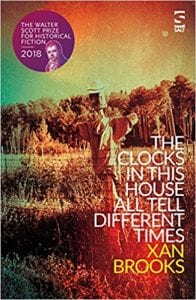The Clocks in This House All Tell Different Times – Xan Brooks
By uczcmsm, on 29 April 2018
Longlisted for the Desmond Elliott Prize 2018
“Grantwood House is a place for marvels and magic and for radical prose.”
The Clocks In This House All Tell Different Times by Xan Brooks is an enchanting, magical tale about the most disturbing and depraved elements of human survival. Taking place a couple years after the first world war, the story follows several characters that have been drastically changed by the conflict that gripped England for so long. Haunted by the challenges presented with trauma, the characters are drawn together through their search for survival and desire for a future.
Lucy Marsh and her brother Tom are orphans of the war effort. Sent to live with their grandparents in an economically failing bar, Lucy and Tom lead average childhoods. That is until one Sunday evening Lucy is invited to the woods for a fantastical meeting of the Funny Men. Lucy, along with orphans Winifred, Jon, and Edith begin meeting with the Funny Men every Sunday evening in exchange for a small monetary stipend paid to their grandparents. A point that Lucy is very proud of. Each of the Funny Men, named after Dorothy’s companions from The Wonderful Wizard of OZ, are residents in the Grantwood Estate charitable foundation for wounded soldiers, and suffered extreme disfigurement during the war. Lucy and the other children perform tasks for the Funny Men that they regard as only mildly distasteful but overall they value the small pleasures afforded to them by the outings. When tragedy strikes the orphans and Funny Men, the activities are forced to end.
However, both Winifred and Lucy contrive a way to continue their enterprise with the Funny Men, becoming increasingly involved with the Grantwood Estate. As the girls are given access to the estate they are pulled into a world of spiritualists, camels, lavish parties, eccentric house guests, trays of cocaine, expensive gowns, and ever flowing alcohol. Grantwood House becomes their world filled with boundless adventure and mysticism. But beneath the surface lies even more terror and danger.
Brooks expertly uses beautifully constructed prose to contrive experiences that are just beyond belief. The humor and happenstance is enthralling and charming which only adds to the horror experienced by the reader as the story slowly reveals the real activities of the Grantwood Estate. The house, just as the novel, possesses a gorgeous exterior that is quickly dispelled for anyone who occupies the space. While Lucy is first enamoured by her work with the Funny Men, that too, loses its appeal with time and experience. Brooks does an excellent job at playing with his readers, ensuring that the characters and activities of the story are never what they initially seem. Furthermore, the story ambitiously tackles themes of poverty, class, war, nostalgia, and disillusionment. Each character’s moral standards are constantly in flux with very little self acknowledgement of contradiction on their behalf. While the novel is written to emulate the style of simpler fairytales, there is nothing simple or pure about this story.
Often, it is the Funny Men, who are called monsters for their appearance. However, Brooks’ characters are all monsters at one point or another, as they blur the lines between wants and needs, survival and desire, choice and entrapment. The Clocks In This House All Tell Different Times is an utterly magical read that will enrage and disgust readers beyond their wildest imagination.
Brittany Yost
The Clocks In This House All Tell Different Times was published by Salt Publishing
 Close
Close







